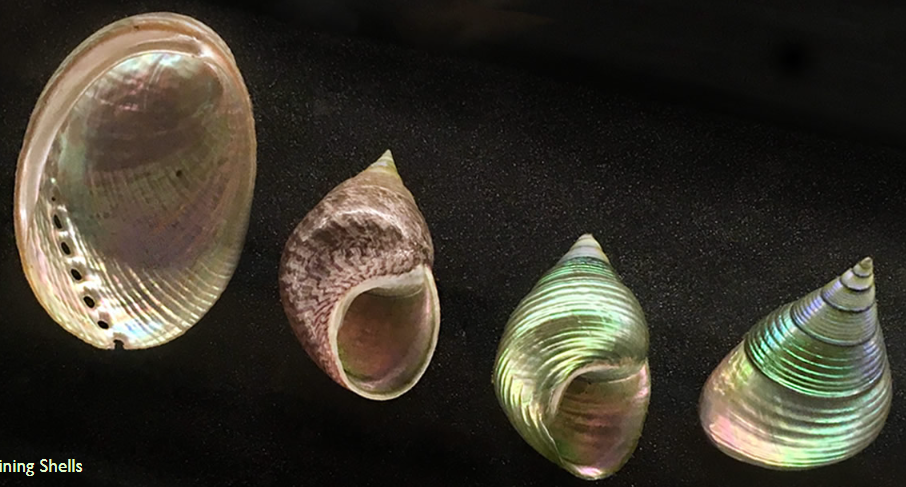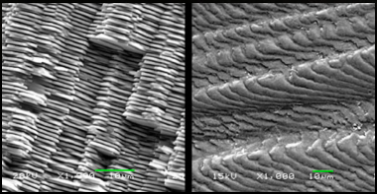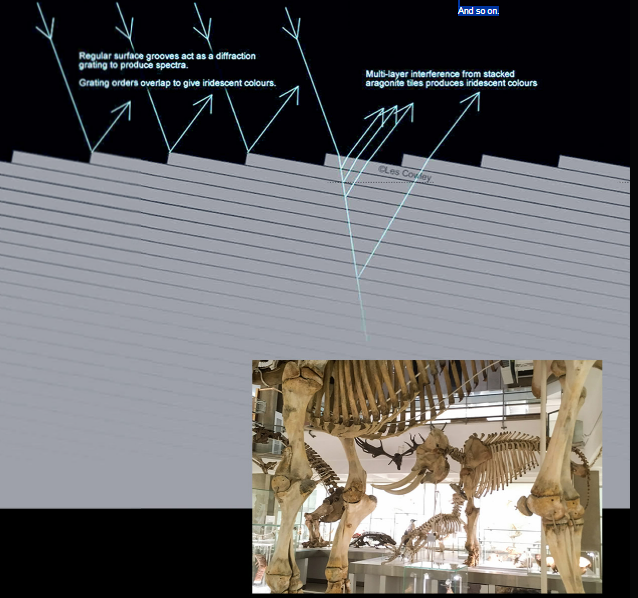Shining Mollusc Shells
Shining Mollusc Shells: Unveiling the Spectacular Colors
Mollusc shells have long captivated the human imagination with their dazzling display of colors. One cannot help but be enchanted by the gem-like radiance that emanates from these exquisite creations of nature. Recently, I had the pleasure of visiting the Museum of Zoology in Cambridge (UK), where I was fortunate enough to witness the brilliance of these shining mollusc shells firsthand. The experience left me in awe, pondering the intricate secrets behind their iridescent allure.
The captivating colors of these shells can be attributed to the remarkable structure of their lining, known as nacre. Nacre is a true marvel of bio-engineering, consisting of polygonal tiles made of a crystalline form of calcium carbonate called aragonite. These tiles, measuring about 10 microns across, are held together by a matrix of conchiolin, polysaccharide, and protein fibers, forming a strong and resilient structure.
The surface of nacre is adorned with uniform microscopic ridges that act as a naturally formed diffraction grating. These ridges play a crucial role in generating the vibrant colors observed in these shells. When light interacts with the nacre surface, some of it penetrates into the layers, enhancing the surface-generated colors through multilayer interference.
But how are these remarkable ridges formed? The process begins with the random nucleation of aragonite on a thin protein layer. Under normal circumstances, crystal growth would occur perpendicular to this layer, following the "c" axis. However, proteins selectively absorb onto the top crystal faces, preventing vertical growth. Instead, horizontal growth takes place until contact with adjacent tiles forces a regular spacing between them.
The regularity of the tile structure is truly astounding and is controlled by protein secretions during its formation. Periodic injections of an inhibitor protein are believed to limit the thickness of each tile to approximately 0.5 microns. As a result, an upper terrace of crystal starts to form on the face of each tile, eventually growing into a second layer. This process continues, layer upon layer, giving rise to the stunningly intricate structure of the nacre.
The connection between these ridges and the vibrant colors exhibited by the shells was first established in the 19th century by David Brewster of Edinburgh University. In his experiments, Brewster created a wax cast of a shell's surface, which astonishingly displayed iridescent colors similar to those seen in the original shell. This groundbreaking discovery provided compelling evidence that the ridges themselves are responsible for the captivating hues observed in mollusc shells.
It is worth noting that the colors observed in these shells can vary greatly, ranging from vivid blues and greens to delicate pinks and purples. This variability arises from the thickness and arrangement of the nacre layers, as well as the angle at which light interacts with the shell's surface. Each mollusc species possesses its own unique combination of factors, resulting in a diverse array of mesmerizing color patterns.
The remarkable phenomenon of shining mollusc shells not only delights our senses but also serves as a testament to the intricate wonders of nature's design. These natural masterpieces, with their iridescent hues and exquisite structures, continue to inspire scientists and artists alike. The exploration of their optical properties not only deepens our understanding of the world around us but also unveils the astonishing beauty hidden within the seemingly ordinary shells that grace our shores.
In conclusion, the shining mollusc shells found in nature's treasure trove are a true marvel. Their radiant colors, brought to life by the intricate ridges and layers of nacre, leave us captivated and in awe of nature's ingenuity. As we delve deeper into the secrets of these shimmering shells, we uncover a world of beauty and complexity that continues to amaze and inspire us.

Shining Shells
I came across these gem-like mollusc shells a few days ago in the Museum of Zoology in Cambridge (UK). This freshly reopened museum is delightful, brain stirring and a must. The image does little justice to the shells, they shone colours brighter than the gems of a jeweller�s window. Their secret lies in the structure of their lining of nacre, a miracle of bio-engineering.
Image ©Les Cowley
The colours come mainly from the nacre surface structure. It has uniform microscopic ridges - A naturally made diffraction grating. Some light penetrates into the nacre and that adds to the surface generated colour by multilayer interference.
Where come the ridges?
Nacre is made up of polygonal (usually hexagonal) tiles of a very hard crystalline form of calcium carbonate, aragonite. Each tile is a single crystal some 10 microns across. A thin matrix of conchiolin, polysaccharide and protein fibres, cements them together into tessellated stacked layers to form a very strong structure.
The edges of the layer stacks form the surface ridges. That the ridges produce the colours was first proved in the 19th Century by David Brewster of Edinburgh University. He made a wax cast of a shell surface. The wax cast also showed iridescent colours!

Stacked layers of aragonite tiles Regularly spaced surface grooves
The green bars represent 10 micron.
Images ©T L Tan, D Wong & P Lee, Iridescence of a shell of mollusk Haliotis Glabra, Optics Express, Vol. 12, Issue 20, pp. 4847-4854 (2004)
The tile structure�s regularity is remarkable. Protein secretions control its formation.
Initially there is random nucleation of aragonite on a thin protein layer. The fastest crystal growth would normally be perpendicular to the layer along the �c� axis but this is rather neatly prevented by the selective absorption of proteins onto the top crystal faces. Horizontal growth proceeds instead and contact with adjacent tiles eventually forces a regular spacing.
Periodic injections of an inhibitor protein is hypothesised to limit the tile thickness to 0.5 micron. An upper terrace of crystal then starts to form on the face of each tile and eventually grows into a second layer.
And so on.

Note: this article has been automatically converted from the old site and may not appear as intended. You can find the original article here.
Reference Atmospheric Optics
If you use any of the definitions, information, or data presented on Atmospheric Optics, please copy the link or reference below to properly credit us as the reference source. Thank you!
-
<a href="https://atoptics.co.uk/blog/shining-mollusc-shells/">Shining Mollusc Shells </a>
-
"Shining Mollusc Shells ". Atmospheric Optics. Accessed on November 26, 2024. https://atoptics.co.uk/blog/shining-mollusc-shells/.
-
"Shining Mollusc Shells ". Atmospheric Optics, https://atoptics.co.uk/blog/shining-mollusc-shells/. Accessed 26 November, 2024
-
Shining Mollusc Shells . Atmospheric Optics. Retrieved from https://atoptics.co.uk/blog/shining-mollusc-shells/.